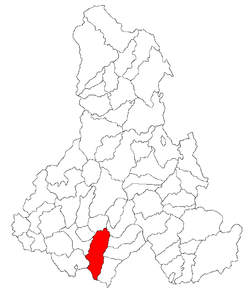Mărtiniș
|
Mărtiniș Homoródszentmárton |
|
|---|---|
| Commune | |

Unitarian church tower
|
|
 Location of Mărtiniș |
|
| Coordinates: 46°14′0″N 25°23′0″E / 46.23333°N 25.38333°ECoordinates: 46°14′0″N 25°23′0″E / 46.23333°N 25.38333°E | |
| Country |
|
| County | Harghita County |
| Status | Commune |
| Government | |
| • Mayor | Tivadar Péter Kerekes (Democratic Union of Hungarians in Romania) |
| Area | |
| • Total | 80 km2 (30 sq mi) |
| Population (2011) | |
| • Total | 2,800 |
| • Density | 38.37/km2 (99.4/sq mi) |
| Time zone | EET (UTC+2) |
| • Summer (DST) | EEST (UTC+3) |
| Postal Code | 537175 |
| Area code(s) | +40 266 |
| Website | www.homorodszentmarton.ro |
Mărtiniș (Hungarian: Homoródszentmárton; Hungarian pronunciation: [ˈhomoroːdsɛnmaːrton], meaning "St. Martin of Homorod") is a commune in Harghita County, Romania. It lies in the Székely Land, an ethno-cultural region in eastern Transylvania.
The commune is composed of twelve villages:
The village seems to have been inhabited already in prehistoric times as a neolithic ax and an urn was found in the ouskirts of the village some decades ago. Roman coins were also unearthed in the village and a small lake reminiscent of the place of an abandoned salt mine suggest that it was also inhabited in Roman times
The village gained its name, when King Géza II of Hungary founded settlements in the Great-Homorod Valley in the middle of the 12th century. The first settlement is thought to be destroyed by the Mongols in 1241. This is supported by the fact that all the churches of the Homorod area were built in a style which is characteristic for the era following the Mongol Invasion. The village is first recorded in a diploma from 1333 when a sacerdos de Sancto Martino was mentioned. In 1487, it is recorded as Zenthmarton, while in 1636, it appears already as Homorod-Szent-Marton. Its Romanian name derives from the Hungarian one and it had at first been Homorod-Sânmărtin and was later changed to the current official name. Its medieval church consecrated in honour of St Martin was built in the 13th century and was altered in the 15th century in late-Gothic style. As the village suffered a Tartar attack in 1613, the church was surrounded by a fortified wall strengthened by six towers. Between 1714-1719, the population was struck by plague. Although, the mediaeval church was pulled down in 1888, the gate-tower of the fortified wall was spared and it now serves as the bell tower of the new Unitarian church built in 1889.
...
Wikipedia
